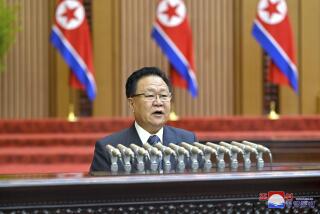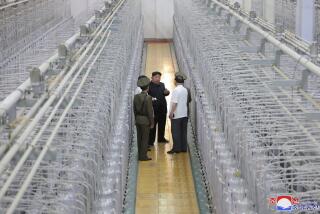Pompeo heads to North Korea to press Kim on nuclear disarmament
Reporting from Washington — Secretary of State Michael R. Pompeo was traveling to North Korea on Thursday to press ruler Kim Jong Un on his stated willingness to disarm his nuclear arsenal, amid reports that Kim actually is expanding the program.
The visit Friday will be Pompeo’s third to Pyongyang, the capital, in three months, but the first since President Trump held a high-profile summit with Kim in Singapore last month. Trump came away saying he trusted Kim to carry through with a promise that the two leaders put in writing to “work toward” denuclearization.
Evidence since then has raised questions about Kim’s intentions, stoking skepticism born of years of North Korea’s broken promises. Pompeo hopes to get answers and a firmer commitment from the young dictator, his aides said, but many within U.S. intelligence, defense and diplomatic agencies cautioned against taking Kim at his word.
North Korea has violated every previous nuclear agreement, reached between Kim’s father and Presidents Clinton and George W. Bush.
Two U.S. officials familiar with intelligence assessments, who would not be identified in discussing classified information, said North Korea intends to hold on to at least a portion of its nuclear arsenal and continue production of long-range ballistic missiles.
The assessments are fully at odds with Trump’s claim, upon his return from Singapore, that Pyongyang no longer poses a nuclear threat.
Kim could still decide to give up a portion of his stockpile, which is estimated to include as many as 60 nuclear devices, in return for security guarantees from the United States, the officials said.
But there is evidence, they added, that he is taking steps to conceal parts of his stockpile and production facilities, intending to preserve a nuclear weapon capability that Kim views as the ultimate guarantor of his dynasty’s survival.
That would confirm what experts on North Korea, including many diplomats and intelligence officers who have dealt with the isolated country, predicted would be Kim’s plan of action.
“There is no sign that Kim has changed his view that possessing a nuclear capability is his best insurance,” one of the officials said.
The classified assessments raise doubts about administration claims that the Trump-Kim summit set the two adversaries on a path toward elimination of North Korea’s nuclear program.
Trump has defended the negotiations with Kim, insisting in a tweet Tuesday that his administration was having “many good conversations with North Korea — it is going well!” and noting that Kim had not carried out “Rocket Launches or Nuclear Testing in 8 months.”
Yet operations at North Korean facilities used to produce nuclear bombs and missiles have continued at least at levels seen before the Singapore summit, according to analyses of recent satellite photos by multiple private researchers.
“All is not going well,” Abraham Denmark, a former Pentagon official during the Obama administration, tweeted in response to Trump’s boast. “There have been several recent reports that NK continues to work on its nuclear and ballistic missile infrastructure. The fact that all of this activity in no way violates the agreement from Singapore shows what a bad deal it was.”
“So far NK is no closer to true denuclearization than it was in 2017,” Denmark added. “How long can the president continue to pretend that, contrary to many indicators, his strategy is working? And what happens then?”
Trump, in comments to reporters Thursday as he flew to a political rally in Montana, again took credit for some success and went so far as to claim that his predecessor was close to war with North Korea.
“You can ask President Obama, he was very close to going to war and he would have lost 50 million people-plus,” Trump said. He also hailed his “good chemistry” with Kim. “I shook his hand,” he said, adding, “I really believe that he sees a different future for North Korea.”
Pompeo had been expected to bring to Pyongyang a more detailed plan to eliminate North Korea’s nuclear stockpile and long-range missiles within a year. The statement that Trump and Kim signed in Singapore contained no details, and Pompeo’s mission is to work those out. “On this trip I’m seeking to fill in some details on those commitments,” the secretary of State said late Thursday in a statement.
Those expectations may be scaled back, given North Korea’s reported actions in recent weeks.
State Department spokeswoman Heather Nauert, traveling with Pompeo, denied Thursday that the administration was going to soften its demands.
“Nothing could be further from the truth,” she told reporters on the flight. “Our policy toward North Korea has not changed. We are committed to a denuclearized North Korea, and Secretary Pompeo looks forward to continuing his consultations with North Korean leaders to follow up on the commitments made at the Singapore summit.”
Trump has repeatedly sought to claim victory after the Singapore meeting, though it produced no concrete results for the United States but immediate benefits for Pyongyang.
The two leaders did not establish an agreed definition of “denuclearization,” yet Trump accepted North Korea’s position that a disarmament process encompass the entire Korean peninsula. That would include the U.S. military presence in South Korea and the region, not just North Korea’s assets.
Trump also quickly agreed to the longtime demand by North Korea — and its chief ally China — to stop long-standing joint U.S. military exercises with South Korea. The annual drills are meant to shore up protection for the South against aggression from the North. South Korea and Japan were shocked at Trump’s offer, which left Pyongyang and Beijing delighted.
Beyond that, North Korea has apparently not stopped its nuclear program.
At Yongbyon Nuclear Scientific Research Center, North Korea’s main nuclear facility north of Pyongyang, infrastructure improvements “are continuing at a rapid pace,” according to 38 North, a group of mostly American analysts specializing in North Korea. The group cited commercial satellite photographs of the area.
Joel S. Wit, a senior fellow with the nonpartisan Stimson Center think tank and founder of the 38 North website, which follows North Korea, said the work is not a definitive signal that North Korea does not intend to eliminate its nuclear weapons.
“The continuation of North Korea’s nuclear and missile programs are a national security concern for the us, but they are not a reliable indicator of whether North Korea intends to denuclearize in the aftermath of the Singapore summit declaration,” Wit said. “No country in the past has stopped building weapons even as negotiations are taking place.”
Pompeo was expected to arrive in Pyongyang midday Friday and stay a day and a half before continuing to Tokyo to meet with Japanese officials.
“Looking forward to continuing our work toward the final, fully verified denuclearization of #DPRK, as agreed to by Chairman Kim,” Pompeo tweeted en route, using the initials of North Korea’s formal name. “Good to have the press along for the trip,” he said, although only two print reporters were allowed on board.
Pompeo has had acrimonious words for reporters who have questioned what exactly Kim had agreed to. The statement Kim and Trump signed called for “complete” denuclearization but did not include two other elements of the U.S. government’s long-standing mantra that the process also be “verifiable” and “irreversible.” Pompeo told one reporter that it was, “frankly, ludicrous” to note that those terms were not present in the communique.
The administration has repeatedly sent mixed signals. National security advisor John Bolton, a steady hawk on most foreign affairs, said Sunday that Pompeo would present to Kim a plan for complete dismantling of the nuclear program in one year. Pompeo has said it would take 2 ½ years. Nauert on Tuesday refused to give a timeline.
State Department officials have repeatedly sought to portray the talks with North Korea as a long and, so far, productive process despite the obvious setbacks.
“We go into this eyes wide open,” Nauert said before Pompeo’s trip. “We’re continuing our conversations and also our consultations with the North Korean government about what the president and what Kim Jong Un agreed to at the Singapore summit. So we obviously have a whole lot to talk about.”
For more on international affairs, follow @TracyKWilkinson on Twitter
UPDATES:
6:05 p.m.: This article was updated with a new quote from foreign affairs analyst Joel S. Wit.
5 p.m.: This article was updated with a statement from Pompeo en route to North Korea.
This article was originally published at 4:05 p.m.
More to Read
Sign up for Essential California
The most important California stories and recommendations in your inbox every morning.
You may occasionally receive promotional content from the Los Angeles Times.












